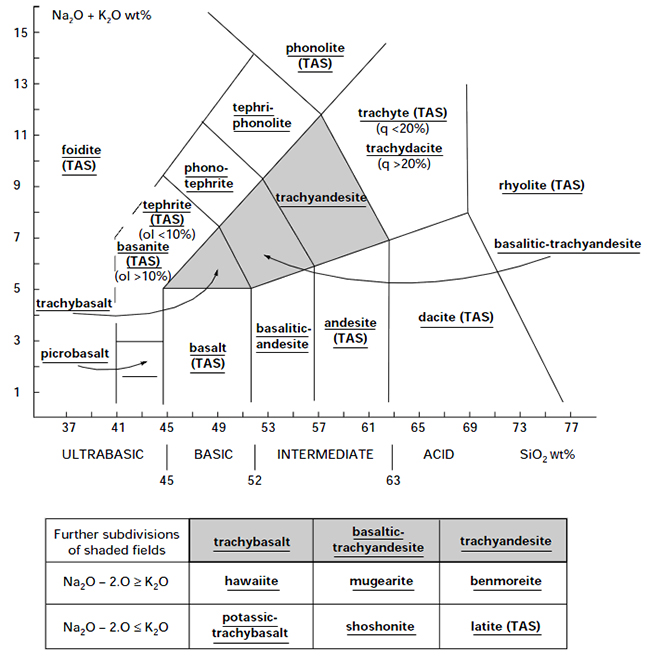There are several rocks and minerals whcih are named after Mull localities. The places after which these are named are referred to as "type localities". Other islands in the Hebridean Palaeogene also have type localities and rocks or minerals named after them. These are given below:
Mull Rocks and Minerals:
Mullite (mineral)
Mullite is an aluminium silicate mineral, formula 3Al2O3 .2SiO2 It occurs rarley in nature and is named after Mull where it was first found. Here is a paragraph from a chapter on Mullite in the book "Ceramic and Glass Materials"
Mullite is a solid solution phase of alumina and
silica commonly found in ceramics.
Only rarely does mullite occur as a natural
mineral. According to introductory remarks
made by Schneider and MacKenzie at the
conference “Mullite 2000”[1], the geologists
Anderson, Wilson, and Tait of the Scottish
Branch of His Majesty’s Geological Survey
discovered the mineral mullite less than a
century ago. The trio was collecting mineral
specimens from ancient lava flows on the island
of Mull off the west coast of Scotland
when they chanced upon the first known natural
deposit of this ceramic material. The
specimens were initially identified as
sillimanite, but later classified as mullite.
The Memoir of the Geological Survey briefly mentions Mullite as the paper describing it was published at the same time as the Memoir. The mineral is first described by Bowen, Greig and Zeiss in the Journal of the Washington Academy of Science in 1924. Norman Bowen was one of the leading igneous geologists of the 20th century.
Web Links:
http://www.handbookofmineralogy.org/pdfs/mullite.pdf
https://en.wikipedia.org/wiki/Mullite
http://webmineral.com/data/Mullite.shtml
http://www.azom.com/article.aspx?ArticleID=925
Tobermorite (mineral)
Tobermorite is a calcium siliscate hydrate mineral, formula Ca5Si6O16(OH)2·4H2O or Ca5Si6(O,OH)18·5H2O. which was first discovered in 1880 by the famous Professor Matthew Forster Heddle, who wrote the two-volume "Mineralogy of Scotland". Heddle's knowledge of Scottish minerals was legendary. The mineral was found by Heddle in three Mull localities, near Tobermory and at Dunvegan in Skye.
Fascinatingly, there is a variety of Tobermorite called "Riversideite". There is a street in Tobermory called Riverside Court! Absolutely no connection whatsoever!
Web Links:
http://www.dakotamatrix.com/mineralpedia/7531/tobermorite
http://www.mindat.org/min-3985.html
http://www.webmineral.com/data/Tobermorite.shtml
Benmoreite (rock)
Benmoreite is a rock, broadly speaking,a form of basalt which is
named after Ben More on the Isle of Mull.
Specifically it is a trachyandesite where the
Na2O is greater than K2O. From the excellent web
site
www.alexstrekeisen.it the description
is given as:
Benmoretite is an extrusive igneous rock consisting of anorthoclase, sodic plagioclase, and iron-rich olivine, and found as a member of the alkali basalt magma series. With increasing differentiation shown by increasing SiO2 content, the series is alkali basalt–hawaiite–mugearite–benmoreite–trachyte. The type locality after which the rock is named is Ben More on the Isle of Mull, Scotland.
On a TAS diagram:

The distinction is quite subtle and it is probably not noticeable in the field. The benmoreite on Ben More occurs near the top of the mountain, where its light colour and platy appearance are distinctive. The term "benmoreite" was first used in a paper published in 1964 by Tilley and Muir entitled: "Intermediate Members of the Oceanic Basalt-Trachyte Association"
Web Links:
http://www.tandfonline.com/doi/abs/10.1080/11035896409455489
http://www.alexstrekeisen.it/english/vulc/benmoreite.php
https://wwwf.imperial.ac.uk/earthscienceandengineering/rocklibrary/viewrecord.php?cID=85
Craignurite (rock)
Named after Craignure (Creag an Iubhair, the rock of the yew tree) in Mull, the main ferry terminal. Craignurite was first named in the Memoir of the Geological Survey. Described as follows in the book "Igneous Rocks - A Classification and Glossary of Terms" by R.W. LeMaitre.
"A local Hebridean name for a series of volcanic rocks occurring as cone sheets and ranging in composition from intermediate to acid. They are characterised by acicular and skeletal crystals of plagioclase, augite and hornblende in a felsic groundmass"
The rock is light grey in colour and forms the foreshore near the Craignure pier. It is also clearly visible at the side of the forestry track that runs up from the Scallastle car park - here there is a lot of freshly broken material so it is easy to find.
Leidleite (rock)
Named after Glen Leidle - the glen that runs from Pennyghael to Carsaig, Leidleite (and the related rock type Inninmoreite, named after the place in Morvern) were discovered during the Survey and first reported in a paper authored by Anderson and Radley in 1915, entitled "The Pitchstones of Mull and their Genesis"
The definition given in the paper is:
"Leidleite.--Rocks of this type are dark
grey in colour, and range in texture from finely
crystalline to glassy--presenting the aspect
sometimes of fine-grained dolerites, sometimes
of pitehstones. The constituent minerals are
plagioclase, augite, and magnetite; while glass
or its products of devitrification are always
present in varying amounts. In the rocks of
doleritie aspect the interstitial matter
consists of cloudy alkali felspar, and quartz,
evidently resulting from the crystallization of
the original glass. The
pitchstones retain their interstitial glass in
an unaltered state"
In the book "Igneous Rocks: A Classification and Glossary of Terms" (ed.LeMaitre, 2002) Leidleite is described as "A local name for an andesitic rock with microlites of plagioclase, augite and iron ore in a fine grained to glassy groundmass"
Craigite (rock)
Craigite is a bit of an odd one. It is only referred to in one document, but that document is an important significant one - the Geologists Association Guide Number 20 "The Tertiary Igneous Geology of the Isle of Mull" The name does not appear to occur anywhere else which suggests that it is an invention of the authors of the Guide.
On the modern BGS map, the rock is indicated as "Breccia-porphyry of Craig" On earlier maps it is described as "Enstatite porphyrite"
-oOo-
Further afield
Harrisite
Alivalite
Mugearite
Marscoite
Strontianite
Inninnmoreite